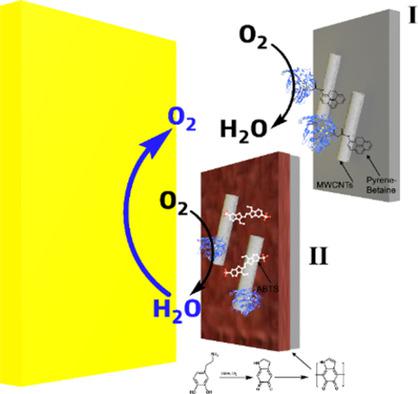当前位置:
X-MOL 学术
›
ChemSusChem
›
论文详情
Our official English website, www.x-mol.net, welcomes your
feedback! (Note: you will need to create a separate account there.)
Bismuth Vanadate/Bilirubin Oxidase Photo(bio)electrochemical Cells for Unbiased, Light-Triggered Electrical Power Generation.
ChemSusChem ( IF 7.5 ) Pub Date : 2020-02-18 , DOI: 10.1002/cssc.202000001 Dina Mukha 1 , Yifat Cohen 1 , Omer Yehezkeli 1, 2, 3
ChemSusChem ( IF 7.5 ) Pub Date : 2020-02-18 , DOI: 10.1002/cssc.202000001 Dina Mukha 1 , Yifat Cohen 1 , Omer Yehezkeli 1, 2, 3
Affiliation

|
The construction of bias- and donor-free photobioelectrochemical cells for the generation of light-triggered electrical power is presented. The developed oxygen reduction biocathodes are based on bilirubin oxidase (BOD) that originates from Myrothecium verrucaria (MvBOD) and a thermophilic Bacillus pumilus (BpBOD). Methods to entrap the BOD with 2,2'-azino-bis(3-ethylbenzothiazoline-6-sulfonic acid) (ABTS) redox molecules in a polydopamine layer are presented. A pH-independent, positively charged pyrenebetaine linker was synthesized, utilized, and led to a threefold improvement to the bioelectrocatalytic current. Both the developed polydopamine/ABTS/MvBOD and the pyrenebetaine/BpBOD biocathodes were further coupled with BiVO4 /cobalt phosphate water-oxidation photoanodes to construct biotic/abiotic photobioelectrochemical cells, which generated power outputs of 0.74 and 0.85 mW cm-2 , respectively. The presented methods are versatile, show the strength of biotic/abiotic hybrids, and can be further used to couple different redox enzymes with electrodes.
中文翻译:

钒酸铋/胆红素氧化酶光(生物)电化学电池,用于无偏,轻触发的发电。
提出了用于产生光触发电功率的无偏压和无施主光生化电化学电池的构造。所开发的氧气还原生物阴极基于胆红素氧化酶(BOD),其起源于疣状支原体(MvBOD)和嗜热短小芽孢杆菌(BpBOD)。提出了在聚多巴胺层中用2,2'-叠氮基双(3-乙基苯并噻唑啉-6-磺酸)(ABTS)氧化还原分子捕获BOD的方法。合成,利用了pH无关的带正电荷的beta甜菜碱连接基,并导致生物电催化电流提高了三倍。将已开发的聚多巴胺/ ABTS / MvBOD和the甜菜碱/ BpBOD生物阴极都与BiVO4 /磷酸钴水氧化光阳极耦合,以构建生物/非生物光生化电化学电池,分别产生0.74和0.85 mW cm-2的功率输出。提出的方法是通用的,显示出生物/非生物杂种的强度,并且可以进一步用于将不同的氧化还原酶与电极偶联。
更新日期:2020-02-18
中文翻译:

钒酸铋/胆红素氧化酶光(生物)电化学电池,用于无偏,轻触发的发电。
提出了用于产生光触发电功率的无偏压和无施主光生化电化学电池的构造。所开发的氧气还原生物阴极基于胆红素氧化酶(BOD),其起源于疣状支原体(MvBOD)和嗜热短小芽孢杆菌(BpBOD)。提出了在聚多巴胺层中用2,2'-叠氮基双(3-乙基苯并噻唑啉-6-磺酸)(ABTS)氧化还原分子捕获BOD的方法。合成,利用了pH无关的带正电荷的beta甜菜碱连接基,并导致生物电催化电流提高了三倍。将已开发的聚多巴胺/ ABTS / MvBOD和the甜菜碱/ BpBOD生物阴极都与BiVO4 /磷酸钴水氧化光阳极耦合,以构建生物/非生物光生化电化学电池,分别产生0.74和0.85 mW cm-2的功率输出。提出的方法是通用的,显示出生物/非生物杂种的强度,并且可以进一步用于将不同的氧化还原酶与电极偶联。











































 京公网安备 11010802027423号
京公网安备 11010802027423号